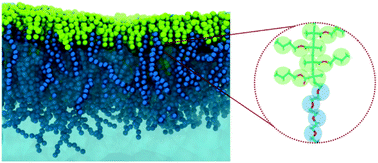Transferable coarse-grained MARTINI model for methacrylate-based copolymers†
Abstract
A versatile and transferable coarse-grained (CG) model was developed to investigate the self-assembly of two ubiquitous methacrylate-based copolymers: poly(ethylene oxide-b-methylmethacrylate) (PEO-b-PMMA) and poly(ethylene oxide-b-butylmethacrylate) (PEO-b-PBMA). We derive effective CG potentials that can reproduce their behaviour in aqueous and organic polymer solutions, pure copolymer systems, and at the air–water interface following a hybrid structural–thermodynamic approach, which incorporates macroscopic and atomistic-level information. The parameterization of the intramolecular CG potentials results from matching the average probability distributions of bonded degrees of freedom for chains in solution and in pure polymer systems with those obtained from atomistic simulations. Potential energy functions for the description of effective intra- and intermolecular interactions are selected to be fully compatible with the MARTINI force-field. The optimized models allow for an accurate prediction of the structural properties of a number of methacrylate-based copolymers of different length over a well-defined range of thermodynamic state points. In addition, we propose a single-segment model for tetrahydrofuran (THF), an organic solvent commonly used in methacrylate-based polymer processing. This model exhibits a fluid phase behaviour close to that observed experimentally and predicted by more sophisticated molecular models and can reproduce the experimental free energy of transfer between water and octanol.



 Please wait while we load your content...
Please wait while we load your content...